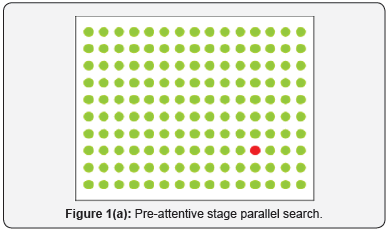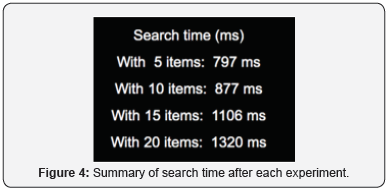Juniper Publishers - Exploring the Response Time (RT) in Performing Specified Visual Search Tasks
Trends in Technical & Scientific Research
Abstract
The ability to identify for a targeting object among other many similar objects is essential to human cognition. The process of object recognition underwent complex cognitive ability and may vary on some factors such as the feature between the target and non-target. Anne Treisman’s Feature Integration Theory (FIT) was used as the blueprint theoretical model to guide the present assignment [1]. The current experiment adopted the classic and simplest visual search paradigm to explore the response time (RT) in performing the specified visual search task. The present pilot run also sought to fill the research gap in studying gender difference in the visual searching task to the existing literature [2].
Keywords: Visual search; Cognitive ability; Feature integration theory; Response time; Gender difference
Abbreviations: FIT: Feature Integration Theory; RT: Response Time; BPS: British Psychological Society; PIS: Participant Information Sheet; SPSS: Statistical Package for the Social Sciences
Introduction
Individuals rely on visual search skills to identify a target among distractors on perceptual dimensions [3]. It is a process of object recognition, and it happens on everyday life such as searching for the desired product in the supermarket, identifying names on a list, or even looking for a food item on a restaurant menu. Many professionals such as medical doctors, airport security demand a high level of vigilance in object recognition among other distractors. The failure of vigilance can cause greatly lost of life and property. Attention is a much-required effort in performing a visual searching task [4,5]. Indeed, attention is a selective process, and it is necessary for cultivating the focus on information that is most relevant and limit the capacity on irrelevant ones [6,7]. Over the years, visual search and the role of attention has been a great interest in literature as an essential perceptual learning task of human cognition [8]. The first paper on visual search was published in 1976, but the rate of publication increased significantly only since 2005 [6]. Anne Treisman’s Feature Integration Theory (FIT) had the greatest influence and laid fundamental framework in elevating visual search study [1]. The core of her theory was to distinct feature on a two-dimensional array from distractors of which could be activated in a parallel search.
The FIT model suggested that the visual search process deploys in two stages: pre-attentive and attentive. In the pre-attentive stage, performing a parallel search can identify a singleton simultaneously [6]. The search can be done almost effortlessly by “pop out” virtue of a sole locus of activity [8,9]. Attentive stage requires more complex effort in serial searching as the target is specifically in conjunction with multiple features and share basic features with the distractors. Eye movements are necessary to perform a sequential serial search [6]. An operational example in pre-attentive (parallel) and attentive (serial) search of a red circle among other distractors was retrieved from Psy Toolkit website and shown in Figure 1 a&b [10,11]. Similar to many classic psychological theories, Treisman’s FIT model has provoked much debate and has rarely been used in visual search study by subsequent researchers. For example, Duncan and Humphreys [3] proposed a new theory of search and visual attention in their research.

Their study results did not support either a distinction between serial and parallel search or between the search for features and conjunctions. Alternatively, they proposed that a continuum of search efficiency. It means that an increased similarity between the target and non-target will increase the difficulty in performing a visual search task and vice versa. Visual search has been traditionally conducted in research laboratories, where the participants were asked to locate and identify a target among distracting items [9]. In a review paper, the primary interest in visual search study included: the modulation of visual attention in perceptual sensitivity, the role of attention, the underlying neuronal responses, and the eye movement during the selection process [6]. The existing research methodology included: psychophysical research, neurophysiological research, neuroimaging study, eyetracking study.

Nevertheless, for the current experiment, the classic visual search paradigm developed along the line with the FIT was used [1]. The present experiment adopted the simplest visual search paradigm. According to Stoet [2], the simplest visual search paradigm consisted of some objects, and participants needed to press a button if a target object is presented among distractor objects and to withhold a response if a target object is not presented. Results are analysed with the response time (RT) and the “search slope”. RT indicates the time taken to analyse the search. RT is typically longer to search for a target object when more items are presented (display size). The increase in search time is typically presented in a regression line as the “search slope”. The steepness of the search slope indicates the effectiveness of the search strategy, and a high level of efficiency is indicated with shallower slopes [1].
In line with theories and existing literature, two research question of the present experiment were proposed as 1) Does the similarity between the target and non-targets affect search times (RT)? 1) Does the number of non-targets affect search times (RT)?
Gender differences
There has been a continuous growth of literature in exploring gender differences in human cognition and cognitive abilities [12]. Many researchers supported robust male advantage marked in spatial awareness, mental rotations and mathematical skills [13,14]. On the other hand, females are in favour with verbal abilities, and phonological verbal fluency [13,14]. However, with the availability substantial amount of studies on visual search, studies on gender difference in performing visual search task has been limited [2]. Stoet [2] was the first research in exploring gender difference in this perspective. He found that men were faster and more accurate in a classic visual search task. However, contradictory results were found by Solianik and colleagues [15]. Employed a cognitive test battery included a visual search task to assess attention, they found no significant gender differences in the mean values in performing the task. Nevertheless, they found that higher variability of memory and attention in women indicated that their performance was lower on these cognitive abilities. In line with existing literature, another research question of the present experiment was proposed as: Do men and women perform differently in visual searching?
Method
Design
The present assignment sought to explore the response time (RT) in performing a visual search task in corresponding to the similarity of the objects and the number of distractors, and gender difference in the performance of computer version of the visual search task. The RT was measured in milliseconds (ms). In comparing gender difference, the between-subjects variable of interest is gender. Gender (two levels: female and male) was the independent variables. The dependent variable was the response time (RT).
Participants
Participants of the present experiment were recruited by convenience sampling. Convenience sampling is a type of nonprobability sampling in which participants are sampled merely because “they are convenient sources of data for researchers”. Present experiment included 3 participants (1 male, 2 female).
Apparatus

It was a web-based learning experiment, and non-nameable stimuli were presented on a computer monitor. Participants were required to identify the target letter T in orange color and regular upright position. Participant needed to press the space bar button if the target object appeared, and to withhold if the target object was not presented (Figure 2). An error message would appear either when the participant did not press the space button if the target object appeared or press the space button when the target object was not presented (Figure 3). There were altogether 50 search displays in the present experiment and the expected completion time of the task was 5 minutes.

There were a combination of 5, 10, 15, or 20 items in each display array. The materials of the current experiment were readily available on the PsyToolkit website, a free online psychological experiments website for and students to use educational or research purposes without further permission [10,11].
Procedure
Research of the present experiment followed the code of human research ethics as published by the British Psychological Society (BPS) in the procedures for valid consent, confidentiality, anonymity, and fair treatment.
Along the line of research ethics, the Participant Information Sheet (PIS) and consent form were presented to the participants before participating in the present experiment. The PIS provided necessary information to the participants in understanding the purpose, methods, risks and benefits of the present experiment. The planned use of the data to be collected was also informed, and thus the participants can decide whether to participate in the present experiment. After understanding the PIS, the participant was invited to sign the consent form. The signed consent form with identifying information was stored separately from the data collected. Therefore, there was no identifying information of the participants’ identity in corresponding to the collected data. Demographic data included age and gender of the participants were collected. Participants were then instructed to visit Psytoolkit website to participate in the experiment and followed the subsequent instructions [10,11].
Result
The data collected from the present experiment are not required to perform any statistical analysis. To analyse the data collected, the following statistical analysis procedures will be followed.
The raw data collected were presented in an output data file in five columns:
I. Blockname,
II. distractor present? (1=yes, 0=no),
III. number of distractors,
IV. status (1=correct, 2=error, 3=too slow), and
V. the response time (RT) (ms).
After running an individual experiment from each participant, the output data was available on the screen for copy and paste onto an excel table. After that, the consolidated output datafile will be converted into statistical software. The statistical software of the Statistical Package for the Social Sciences (SPSS) will be used to perform statistical analysis, and the results are being presented as follow. Results with p < 0.05 were considered statistically significant.
To have an overview of the data collected, the descriptive statistics of the participants and the performance on each attempt will be presented. The descriptive statistics will include the means, standard deviations, and test statistics for each attempt. To address the first two research questions, search times (RT) will be analysed by performing a visual search task in corresponding to the similarity of the objects and the number of distractors. A quick summary of the search times was available after the completion of each experiment (Figure 4). To analysis, if there is a significant difference in RT in correspond with the number of items in the display array, an independent samples t-test can be used. The t-test is used to assess whether there is a statistically significant difference between the means of the two conditions

To address the third research question on gender difference in performing a visual search task, analyses for the experimental task can be done by a mixed analysis of variance (ANOVA). ANOVA is the parametric equivalent of the t-test and is used when more than two groups are presented [16]. In the present experiment, the between-subject factor “gender” (female vs male). In performing repeated-measures analyses, Mauchly’s test of sphericity will be used. A repeated measures ANOVA with a Greenhouse-Geisser correction will be used to determine if there is a significant difference between males and females in performing the task.
Apart from the response time (RT), a search slope will be used to analyse the search speed and accuracy. The search slope indicates how much slower a participant gets with each additional item in the search displays [2]. The search slope will be calculated in a liner regression with the set size as the independent variable.
Framework
The present experiment sought to fill the research gap in exploring gender difference in the visual searching task to the existing literature [2]. ANOVA is seemed to be an appropriate methodology in examining the statistical difference between males and females in performing a visual search task. However, the raw output data elicited difficulty in performing such statistical analysis. To look at the between-group significance, a composite index is required to summarise the overall performance in accordance to the response status (correct, error, too slow), and the response time (RT). The appropriate formula in calculating a composite index ought to be further explored. Similar to many existing visual search study, one limitation of the present experiment design is the focus of the research. Indeed, many of the existing visual search studies focus on distractor suppression, but the secondary inhibition mechanism has not been much emphasized [7]. Nevertheless, the inhibitory mechanism is ubiquitous and should play a key role in visual information processing [17,18]. Another limitation of the current project can be the sample size.
The limited sample size may reduce the power of the present project and increase the margin of error. Also, a small sample size tends to increase the Type II error in skewing the results. Sample size calculation in the early stages of any research study is an ethical and scientific consideration [19]. However, there has been limited guidance on how the sample size of a pilot study should be, and the views of the researchers seem varied. According to Hertzog [20], it is a general guideline to use 10% of the sample size of a full study. Viechtbauer and colleagues [21] suggested that if a 95% confidence is identified in a full study, then 5% of the sample size of a full study should be included. Nevertheless, the rule of thumb to calculate the sample size is essential to conduct any kind of research [22-23].
As a personal reflection of experience in designing the present experiment from scratch, there have been hurdles. It seems reasonable to adopt a top-down process of designing an experiment by identifying a research question with an extensive literature review [24]. However, it sounds more practical to look at the research methodology and more importantly, the experimental materials for guidance to narrow down the focus on the literature review [25]. Indeed, there is a vast amount of existing literature available on visual search. The review process can easily get lost track. All in all, it has been a valuable experience to be in part of the present experiment, and it provides direction in kicking off the dissertation project shortly.
To Know More About Trends in Technical and Scientific Research Please click on:
To Know More About Open Access Journals Please click on:




Comments
Post a Comment